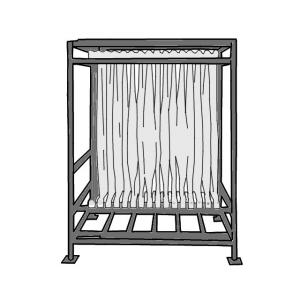Membrane Bioreactors Explained: Reliable Solutions for Clean Water
Membrane layer bioreactors (MBRs) have actually become an innovative option for addressing journalism challenges of wastewater treatment. By integrating organic processes with advanced membrane layer filtering, MBRs not only enhance the top quality of treated water but likewise decrease the spatial requirements of treatment centers. As ecological problems heighten, the duty of MBR modern technology in promoting sustainable water management ends up being progressively considerable. Nevertheless, the intricacies of their procedure, advantages, and possible applications warrant a closer exam to fully comprehend their effect on the future of water therapy.

What Are Membrane Layer Bioreactors?
Membrane layer bioreactors (MBRs) are advanced wastewater treatment systems that combine organic destruction procedures with membrane layer purification technology. This assimilation permits the reliable removal of contaminants from water, making MBRs a recommended selection in various applications, consisting of metropolitan wastewater treatment and industrial effluent management.

Among the essential advantages of MBRs is their capacity to create top quality effluent, commonly suitable for reuse in watering or industrial processes. In addition, MBRs need a smaller sized footprint contrasted to traditional therapy systems, making them excellent for metropolitan setups where room might be restricted.
Furthermore, MBRs can successfully deal with differing influent tons and are less at risk to the effects of hazardous shocks. These features add to their expanding appeal as a sustainable service for addressing the boosting need for clean water while lessening environmental effects.
Just How Membrane Layer Bioreactors Work
While the procedure of membrane layer bioreactors (MBRs) may seem complicated, it fundamentally focuses on the harmony in between biological processes and membrane layer purification. MBRs incorporate a biological therapy procedure, usually turned on sludge, with a membrane layer splitting up unit to treat wastewater effectively.
In an MBR system, wastewater is initial introduced into a bioreactor where microorganisms deteriorate organic issue and various other contaminants. The biological activity lowers the focus of toxins while advertising the development of biomass. Following this biological treatment, the mixed liquor is subjected to membrane filtering, which can be microfiltration or ultrafiltration, relying on the preferred effluent high quality.
The membrane layers act as a physical barrier, allowing water and little solutes to pass while retaining put on hold solids and bigger particles. This makes it possible for the system to keep a high concentration of biomass within the activator, boosting the treatment performance.
Additionally, the continual splitting up of cured water from the biomass facilitates a portable layout and lessens the impact of the therapy facility. In general, the combination of organic degradation and membrane layer purification in MBRs leads to reliable and reliable wastewater therapy, guaranteeing premium effluent appropriate for various applications.
Benefits of MBR Innovation
One of the essential advantages of membrane layer bioreactor (MBR) technology is its ability to produce high-grade effluent with a dramatically minimized footprint compared to standard wastewater treatment approaches. MBR systems efficiently integrate biological therapy and membrane filtering, resulting in superior elimination of impurities, consisting of suspended solids, pathogens, and raw material. This ability results in effluent that frequently fulfills or exceeds rigorous regulatory standards for reuse and discharge.
In addition, MBR technology permits higher biomass focus, which boosts the treatment performance and reduces the visit needed activator quantity. This small layout is especially valuable in urban areas where area is restricted. The operational versatility of MBR systems additionally indicates they can adjust to varying influent high qualities and circulation rates, making them appropriate for a vast range of applications.
In addition, the decreased sludge manufacturing related to MBR processes adds to lower functional and upkeep prices. The membrane layers act as a physical obstacle, reducing the threat of blocking and enabling longer operational periods between cleaning. Generally, the benefits of MBR modern technology make it an attractive remedy for sustainable wastewater treatment, dealing with both environmental issues and the need for effective source administration.
Applications of Membrane Layer Bioreactors
With their flexibility and effectiveness, membrane layer bioreactors (MBRs) discover applications across various industries, including community wastewater treatment, industrial procedures, and also water recovery. In local setups, MBRs supply a portable solution for treating wastewater, successfully getting rid of impurities while simultaneously producing top notch effluent that find this meets stringent governing requirements. This makes them especially ideal for locations with minimal area.
In industrial applications, MBR innovation is used for treating procedure water, specifically in industries such as food and beverage, drugs, and petrochemicals. These markets gain from MBRs' capability to manage high organic lots and their efficiency in recuperating useful resources from wastewater, such as nutrients and water.
Moreover, MBRs play a more crucial duty in water recovery campaigns, allowing the reuse of treated wastewater for watering, commercial procedures, or perhaps as safe and clean water after additional therapy (Membrane Bioreactor). Their effectiveness in eliminating toxins and pathogens makes them a trusted option for guaranteeing water quality in numerous reuse applications
Future of Water Treatment Solutions
The future of water therapy options is poised for transformative innovations driven by technological technology and enhancing ecological awareness. As international water deficiency comes to be a pressing problem, brand-new approaches, including membrane layer bioreactor (MBR) systems, are set to play an essential duty in improving the effectiveness and sustainability of water therapy procedures.
Emerging modern technologies such as man-made knowledge and artificial intelligence are anticipated to enhance therapy operations, enabling real-time tracking and predictive upkeep. This will certainly boost the total dependability and effectiveness of water treatment centers. Developments in membrane materials, such as graphene and nanofiltration, promise to boost permeation prices and reduce fouling, leading to reduced power consumption and functional expenses.
In addition, the integration of renewable resource resources right into water therapy plants will certainly add to greener methods. The circular economic situation version will likewise gain grip, encouraging the healing of important resources from wastewater, such as nutrients and energy.
Conclusion

Membrane bioreactors (MBRs) have actually emerged as a sophisticated remedy for attending to the pushing difficulties of wastewater treatment. By integrating organic processes with sophisticated membrane layer filtering, MBRs not only boost the high quality of cured water but also lower the spatial needs of therapy facilities.One of the essential advantages of membrane layer bioreactor (MBR) technology is its capability to produce top quality effluent with a considerably lowered footprint contrasted to traditional wastewater therapy methods.With their adaptability and efficiency, membrane layer bioreactors (MBRs) discover applications throughout numerous sectors, including community wastewater therapy, commercial processes, and even water improvement.In conclusion, membrane layer bioreactors stand for a substantial development in wastewater treatment innovation, incorporating organic procedures with reliable membrane purification to produce premium effluent.
 Romeo Miller Then & Now!
Romeo Miller Then & Now! Andrea Barber Then & Now!
Andrea Barber Then & Now! Tiffany Trump Then & Now!
Tiffany Trump Then & Now! Kelly Le Brock Then & Now!
Kelly Le Brock Then & Now! Kane Then & Now!
Kane Then & Now!